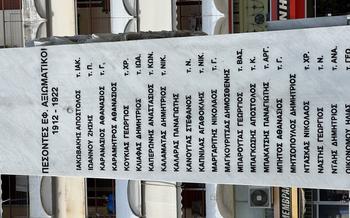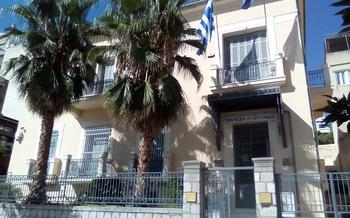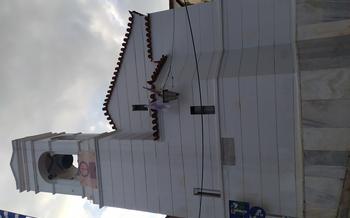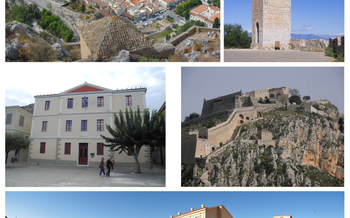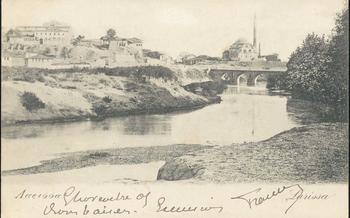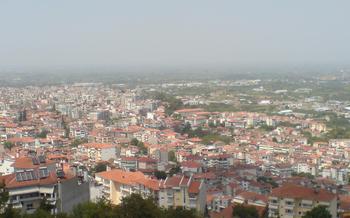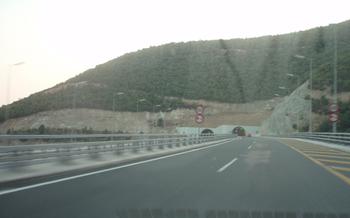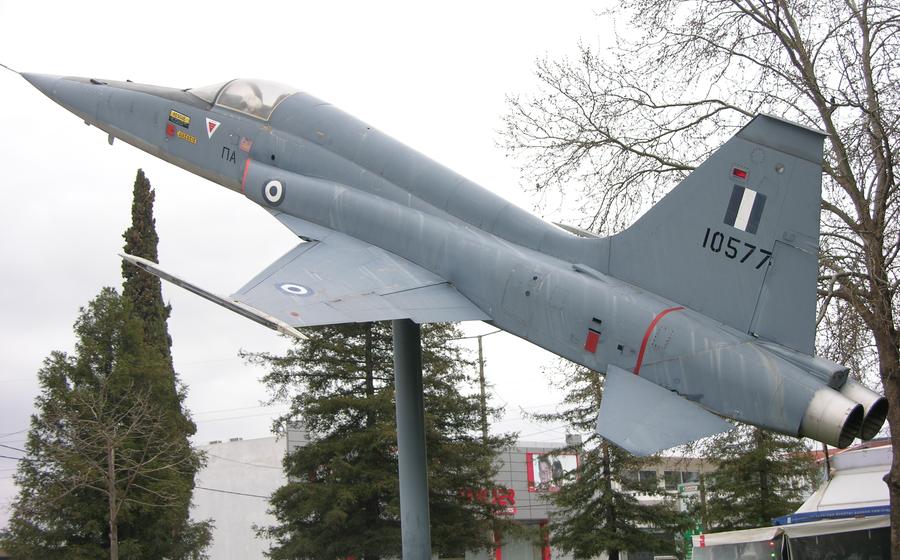
Church of Agia Paraskevi
- The Church of Agia Paraskevi
- Location and Accessibility
- History and Background
- Architectural Highlights
- Religious Significance
- Must-See Icons
- Visiting Tips
- Opening Hours and Services
- Things to Do Nearby
- Suggested Itineraries
- Local Traditions and Customs
- Historical Context
- Architectural Comparison
- Religious Practices
- Cultural Significance
- Insider Tip: Unveiling Hidden Gems and Stories
The Church of Agia Paraskevi
Historical Significance: The Church of Agia Paraskevi, nestled in the heart of Lamia, holds immense historical significance. Built in the 10th century, it stands as a testament to the rich Byzantine heritage of Greece. As one of the oldest churches in the region, it has witnessed centuries of religious devotion, cultural exchange, and historical events, leaving an indelible mark on the tapestry of Lamia's history.
Architectural Features: Architecturally, the Church of Agia Paraskevi is a masterpiece of Byzantine design. Its intricate stonework, adorned with delicate carvings, showcases the exceptional craftsmanship of the era. The church's distinctive octagonal dome, a hallmark of Byzantine architecture, towers over the surrounding buildings, symbolizing the spiritual grandeur within.
Religious Importance: The Church of Agia Paraskevi holds a profound religious significance for the Greek Orthodox community. Dedicated to Saint Paraskevi, a widely revered saint known for her healing powers and compassion, the church attracts pilgrims from far and wide seeking her blessings and intercession. Saint Paraskevi is considered the patron saint of Lamia, and the church serves as a spiritual haven where devotees come to pray, offer votive offerings, and seek solace.
Must-See Icons: Within the church, visitors can marvel at the exquisite collection of icons, each narrating a chapter from the life of Saint Paraskevi and other revered saints. The main icon of Saint Paraskevi, meticulously crafted with gold leaf and vibrant colors, captures her essence and devotion. Other notable icons depict scenes from the Bible, offering a glimpse into the rich iconographic tradition of the Greek Orthodox Church.
Location and Accessibility
The Church of Agia Paraskevi is situated at 1 Platia Ag. Paraskevis, in the heart of Lamia, Greece. It stands as a prominent landmark, easily accessible from various parts of the city.
Getting There:
Public Transport: - Several local bus routes have stops within walking distance of the church. - The closest stop is called "Agia Paraskevi Church."
Driving: - If driving, you can park your vehicle in the nearby municipal parking lot. - The parking lot is a 5-minute walk from the church.
Walking: - The church is within easy walking distance from many hotels and attractions in Lamia. - It takes about 10-15 minutes to walk from the city center.
Nearby Attractions:
- The Archaeological Museum of Lamia, showcasing artifacts from the region's rich history.
- The Lamia Central Park, offering a tranquil oasis for relaxation and recreation.
- The Lamia Castle, a historical fortress with stunning views of the city and surrounding landscape.
History and Background
The origins of the Church of Agia Paraskevi can be traced back to the 12th century, during the Byzantine era. According to local legend, the church was built on the site of an earlier Christian basilica that had been destroyed by fire. The current structure was erected by a wealthy local merchant named Ioannis Angelopoulos, who was said to have been miraculously cured of a serious illness after praying to Saint Paraskevi.
Over the centuries, the church underwent several renovations and additions. In the 16th century, a bell tower was added to the western facade. In the 18th century, the interior of the church was decorated with frescoes depicting scenes from the life of Saint Paraskevi. The church also survived several earthquakes and wars, including the Greek War of Independence in the 19th century.
Today, the Church of Agia Paraskevi stands as a testament to the resilience and faith of the Greek people. It is a reminder of the rich history and cultural heritage of Lamia and continues to be an important place of worship for the local community.
Architectural Highlights
The Church of Agia Paraskevi boasts a remarkable blend of Byzantine and Greek architectural elements that sets it apart from other churches in Lamia. Its exterior facade showcases intricate brickwork and stone carvings that depict religious scenes and patterns. The main entrance is adorned with a grand arch supported by ornate columns, inviting visitors into the sacred space.
Stepping inside the church, one is struck by the spacious and well-lit interior. The layout follows the traditional cruciform plan, with a central dome supported by four massive pillars. The dome's interior is decorated with vibrant frescoes depicting biblical scenes and the life of Saint Paraskevi, creating a celestial ambiance.
Notable architectural elements include the finely carved iconostasis, which separates the sanctuary from the nave. The intricate wooden carvings depict various saints and scenes from the Bible, adding to the church's rich visual appeal. The church also features beautiful stained glass windows that filter sunlight, casting colorful hues onto the interior walls.
Compared to other Byzantine churches in Greece, the Church of Agia Paraskevi stands out for its relatively compact size and its unique blend of architectural influences. Its combination of Byzantine, Greek, and local elements reflects the diverse cultural heritage of Lamia and makes it a captivating example of religious architecture.
Religious Significance
The Church of Agia Paraskevi holds deep religious significance for the Greek Orthodox community in Lamia and beyond. Saint Paraskevi, also known as Saint Friday, is a highly revered figure in Greek Orthodox Christianity, known for her healing powers and her protection against eye diseases.
Pilgrims from across Greece and neighboring countries flock to the church to seek her blessings and pray for her intercession. The church is a popular destination for religious festivals and events, particularly on Saint Paraskevi's feast day, which is celebrated on July 26th.
During these festivals, the church is adorned with flowers and decorations, and special services are held to honor the saint. Local residents participate in processions, carrying the icon of Saint Paraskevi through the streets of Lamia. These festivals are a vibrant display of faith and devotion, attracting thousands of visitors each year.
Beyond its religious significance, the church also plays an important role in the community. It serves as a gathering place for locals, who come together for religious services, social events, and charitable initiatives. The church's priests and volunteers are actively involved in community outreach programs, providing support and assistance to those in need.
The Church of Agia Paraskevi is a spiritual beacon for the people of Lamia, offering comfort, guidance, and a sense of belonging. Its religious significance is deeply intertwined with the cultural and social fabric of the city, making it a cherished landmark for both locals and visitors alike.
Must-See Icons
The main icon of Saint Paraskevi, prominently displayed within the church, is a stunning portrayal of the revered saint. Depicted in full regalia, holding a cross and a scroll, the icon exudes an aura of serenity and divine grace. The intricate details and vibrant colors of the iconography bring to life the legend of Saint Paraskevi, a symbol of purity, healing, and protection.
Beyond the main icon, several other notable icons and murals adorn the walls of the Church of Agia Paraskevi, each with its own unique story and significance. These sacred artworks showcase the talent and devotion of skilled Byzantine artists, capturing the essence of religious narratives and the saints they depict.
One striking icon depicts the martyrdom of Saint Paraskevi, portraying her unwavering faith amidst adversity. Another mural depicts the saint interceding on behalf of those in need, highlighting her role as a protector and healer. These icons and murals serve as visual reminders of the enduring presence and guidance of Saint Paraskevi, inviting visitors to reflect on her virtues and seek her divine intercession.
To ensure the preservation of these sacred treasures, ongoing conservation efforts are diligently undertaken. Skilled artisans meticulously restore and maintain the icons, ensuring their vibrant colors and intricate details remain intact for generations to come. This dedication to preserving the church's artistic heritage allows visitors to continue experiencing the awe-inspiring beauty and spiritual significance of these sacred artworks.
Visiting Tips
When visiting the Church of Agia Paraskevi, it's essential to observe proper etiquette to respect the religious significance of the site. Dress modestly and avoid wearing shorts, tank tops, or revealing clothing. Photography is generally permitted inside the church, but flash photography and tripods are not allowed. During religious services, it's important to be respectful and maintain silence. Avoid talking, walking around, or taking photos during these times. The best time to visit the church for a serene and contemplative experience is outside of service hours, when you can appreciate its beauty and tranquility without distractions.
Opening Hours and Services
The Church of Agia Paraskevi welcomes visitors during specific hours to ensure a respectful and serene environment. Regular hours of operation are from 8:00 AM to 1:00 PM and 4:00 PM to 7:00 PM daily. These hours may vary slightly during religious holidays or special observances, so it's advisable to check ahead to avoid any inconvenience.
For those seeking a more immersive experience, the church holds religious services and observances throughout the week. Visitors are welcome to attend these services, which offer a glimpse into the spiritual traditions and practices of the Greek Orthodox faith. The Divine Liturgy, a central sacrament in Orthodox Christianity, is held every Sunday morning and on major feast days.
If you wish to inquire about specific services, reservations, or guided tours, contact the church office at [phone number] or [email address]. The church staff is dedicated to assisting visitors and providing information to enhance their understanding and appreciation of the sacred space.
Things to Do Nearby
In addition to exploring the Church of Agia Paraskevi, there are several other attractions within easy walking distance that visitors can enjoy. The Lamia Archaeological Museum is just a few minutes away and houses a collection of artifacts from the region's rich history. For those interested in contemporary art, the Lamia Municipal Art Gallery showcases works by local and national artists.
For a taste of local life, head to the Central Market, where vendors sell fresh produce, herbs, spices, and traditional Greek delicacies. Visitors can also find souvenirs and handicrafts at the nearby shops and boutiques, which line the streets of Lamia's historic center.
After a day of sightseeing, relax and enjoy a meal at one of the many restaurants in the area. From traditional Greek tavernas to modern cafes, there are options to suit every taste and budget.
Suggested Itineraries
To make the most of your visit to Lamia, consider combining your visit to the Church of Agia Paraskevi with other nearby attractions. Here are a few suggested itineraries:
Option 1: - Start your day with a visit to the Church of Agia Paraskevi to admire its stunning architecture and religious significance. - Afterwards, head to the Lamia Archaeological Museum to learn about the region's history and culture. - Take a leisurely stroll through the city center, stopping to admire the historic buildings and shop for souvenirs. - End the day with a delicious dinner at a traditional Greek taverna.
Option 2: - Begin your morning with a visit to the Central Market to experience the sights, sounds, and smells of local life. - Next, visit the Lamia Municipal Art Gallery to admire the works of talented artists. - After lunch, visit the Church of Agia Paraskevi to marvel at its religious significance and architectural beauty. - Conclude your day with a relaxing walk along the banks of the Spercheios River, enjoying the sunset views.
Whether you choose to follow a suggested itinerary or create your own, there's something for everyone to enjoy in Lamia. From historical and cultural attractions to delicious cuisine and vibrant markets, this charming city offers a wealth of experiences for visitors to discover.
Local Traditions and Customs
The Church of Agia Paraskevi is deeply intertwined with the local traditions and customs of Lamia. Every year, on July 26, the church celebrates the feast day of Saint Paraskevi with a grand festival. The festival attracts thousands of pilgrims and visitors who come to pay their respects to the saint and participate in the festivities. During the festival, the church is decorated with flowers and lights, and a special liturgy is held. Traditional Greek music and dance performances fill the air, and there are food stalls selling local delicacies. The festival is a joyous occasion for the community, and visitors can experience the vibrant spirit of Greek Orthodox culture firsthand.
In addition to the annual festival, there are other unique traditions associated with the church. For instance, it is customary for women who are pregnant or seeking to conceive to pray to Saint Paraskevi for her intercession. There is a belief that the saint has the power to bless women with fertility and help them have healthy children. Many women have shared stories of how their prayers to Saint Paraskevi were answered, and the church has become a popular pilgrimage site for those seeking her blessing.
Historical Context
The Church of Agia Paraskevi stands as a testament to the rich history of Lamia, a city that has witnessed the rise and fall of empires, cultural shifts, and religious transformations. Constructed during the Byzantine era, the church played a pivotal role in shaping the spiritual and cultural landscape of the region.
During the Ottoman occupation, the church remained a beacon of hope and resilience for the Christian community of Lamia. Despite facing restrictions and persecution, the faithful continued to gather within its walls, preserving their religious traditions and identitas. The church's endurance through these challenging times speaks to the deep devotion of the local people and the enduring power of faith.
In the 19th century, Lamia experienced a period of economic and cultural revival, and the Church of Agia Paraskevi underwent significant renovations. These renovations not only restored the church to its former glory but also reflected the changing architectural styles and artistic influences of the time. The church's current appearance is a blend of Byzantine, Ottoman, and neoclassical elements, showcasing the diverse historical influences that have shaped Lamia's cityscape.
Architectural Comparison
The Church of Agia Paraskevi stands out among Byzantine churches in Greece for its unique architectural features. While sharing similarities in design principles and construction techniques, it possesses distinct characteristics that set it apart from its counterparts.
In terms of size and grandeur, Agia Paraskevi is relatively modest compared to other prominent Byzantine churches. Its compact dimensions create a sense of intimacy and coziness, allowing visitors to appreciate its intricate details up close.
One of the most striking features of the church is its exterior ornamentation. The facade is adorned with delicate carvings, intricate patterns, and decorative elements that showcase the skill and artistry of Byzantine craftsmen. These intricate details add a layer of visual interest and depth to the church's exterior, making it a delight to behold.
Another distinguishing characteristic of Agia Paraskevi is its interior layout. The church features a single nave with a semi-circular apse at its eastern end. The nave is supported by a series of arches that rest on massive columns, creating a sense of spaciousness and grandeur. The apse, which houses the altar, is adorned with beautiful frescoes depicting religious scenes and figures, adding to the church's spiritual ambiance.
Compared to other Byzantine churches in Greece, Agia Paraskevi exhibits a blend of architectural influences. While its overall design follows the traditional Byzantine style, it incorporates elements of local architectural traditions. This fusion of styles is evident in the use of local materials and construction techniques, which lend the church a unique character and charm.
Overall, the Church of Agia Paraskevi is a remarkable example of Byzantine architecture, showcasing both traditional elements and distinctive features. Its compact size, intricate ornamentation, and unique interior layout set it apart from other Byzantine churches in Greece, making it a must-visit destination for anyone interested in religious architecture and history.
Religious Practices
The Church of Agia Paraskevi is an active place of worship for the Greek Orthodox community in Lamia. Visitors are welcome to observe religious services and rituals, but it is important to be respectful and mindful of the sanctity of the space. Common religious practices include:
-
Divine Liturgy: The main Sunday service, typically held in the morning, involves prayers, hymns, and the sacrament of Holy Communion.
-
Baptisms: Baptisms are performed in a designated area within the church, usually following a set ritual and involving the immersion of the infant or child in holy water.
-
Weddings: Weddings are conducted according to Orthodox traditions, with the exchange of vows, rings, and crowns, followed by a celebration and reception.
-
Funerals: Funerals are held with reverence and respect, involving prayers, hymns, and the final farewell to the deceased before burial.
-
Pilgrimages: The church attracts pilgrims from across Greece and beyond, who come to venerate the relics of Saint Paraskevi and seek her intercession and blessings.
-
Prayer Services: Visitors can light candles and offer prayers at the various icon stands within the church, seeking guidance, comfort, or thanksgiving.
Cultural Significance
The Church of Agia Paraskevi stands as a proud symbol of Greek Orthodox culture and identity, deeply woven into the fabric of Lamia's heritage. It serves as a sacred space where the community gathers to celebrate their faith, preserve their traditions, and foster a sense of belonging. Throughout the year, the church organizes various events and programs aimed at promoting Greek culture and bridging the gap between generations. These initiatives range from traditional dance performances and music concerts to educational workshops and exhibitions showcasing local crafts and customs.
By actively engaging with the community, the Church of Agia Paraskevi plays a pivotal role in safeguarding the rich cultural heritage of Lamia and Greece as a whole. It provides a platform for cultural exchange, where visitors can immerse themselves in the vibrant traditions of the region and gain a deeper understanding of the Greek Orthodox faith. Through its dedication to preserving and promoting Greek culture, the church contributes to the ongoing legacy of this proud and ancient civilization.
Insider Tip: Unveiling Hidden Gems and Stories
Beyond the visible splendor of the Church of Agia Paraskevi, there lie hidden details and stories waiting to be discovered. Take a moment to explore the intricate carvings and frescoes adorning the exterior walls, each narrating a biblical tale or depicting a saintly figure. Step inside and gaze upon the magnificent iconostasis, adorned with rows of exquisitely painted icons that seem to come alive under the flickering candlelight. Don't miss the small chapel hidden behind the altar, dedicated to Saint George, where you might find local devotees offering prayers and lighting candles. If you're lucky, you might encounter the resident priest, Father Ioannis, who is known for his warmth and knowledge. He'll gladly share fascinating stories about the church's history, the miracles attributed to Saint Paraskevi, and the deep faith of the local community. Remember to ask him about the ancient well located beneath the church, said to possess healing properties.


